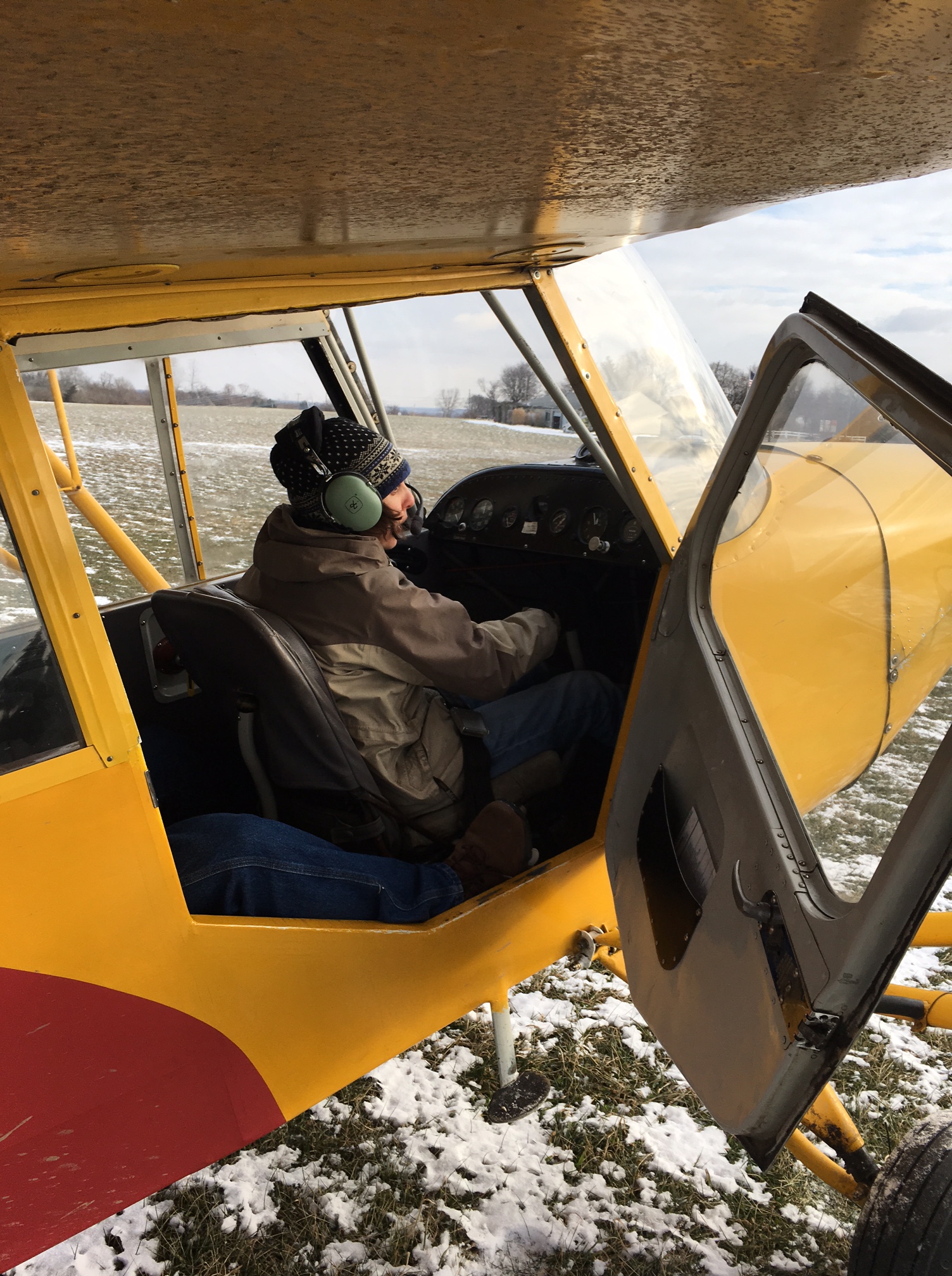
My husband Jason and I spend Christmas week with his parents in Cincinnati. Jason’s dad is taking flying lessons, and as a holiday gift, he booked time for Jason and me to each take a guided spin on a 1946 two-seater “trainer” plane (an Aeronca Champ). The learner, who sits in the front, shares the controls with an instructor behind them. When it was my turn, my instructor ascended us about a thousand feet above ground, and once we were at a safe altitude, I was able to play with the controls, and could make turns with minimal guidance. I also got to tactually observe how the controls were used when my instructor landed the plane.
As a blind person, I’m legally barred from operating any motor vehicle on my own. So these rare moments at the controls of a motor vehicle (even in a gaming context) have a kind of forbidden-fruit allure for me. And, as we were up in the sky, I reflected on the popular idea that driving a car and flying a plane are considered beyond the outer limits of a blind person’s capability. This made me reflect on the dynamic, constructed nature of the disability concept.
In the United States, a disability is legally defined as a physical or mental impairment that “substantially limits one or more major life activities; a record of having such impairment; or being regarded as having such impairment.” Some of the “major life activities” included under this definition are seeing, hearing, walking, standing, lifting, speaking, learning, or concentrating. Read more about the legal definition here
This definition has always bothered me, and seems inadequate. Who decided that seeing, hearing, walking and speaking are “major life activities?” And how much ableism is wrapped up in that classification?
I consider actions like seeing, hearing, walking, and speaking to be means rather than ends. They are methods of accomplishing higher-order human tasks that can be very effective, but are not essential. Sometimes alternative methods-using technology, creativity, or interdependence-can get the job done just as well. Other times, alternative methods work but have limitations, and there are some cases when alternative methods haven’t yet been dreamed up. Furthermore, each person values some life activities more than others. So, perhaps true disability occurs when a person is blocked from achieving personally important goals (or universal goals, like obtaining food and shelter) because of unmitigated barriers related to their impairment.
I spent much of my childhood engrossed in brailled novels. Today, I spend most of my waking hours with a computer on my lap and an earbud in one ear. Both reading and computer use were once completely impossible for blind people. When Louis Braille (the inventor of braille, whom I will write about next week) was a boy growing up in 19th-century France, he was told that blind children couldn’t read and write, and that was just the fact of the time. Not too long ago, I would have been told that a career working with data was impossible for me. A simple piece of text-to-speech technology means I can pick up a computer without a second thought. In theory, then, there may come a day when a blind 16-year-old happily drives out of the DMV parking lot with the same excitement as their peers. The realm of possibility evolves as innovation reveals the flexibility of human capability.
Disability is a spectrum, not a dichotomy. There are some life activities that may be completely unaffected by a person’s impairment. Others may be affected to a small or large extent. Their ease of completion may depend on the environment; for example, navigating in a power wheelchair on flat terrain may be as or moore efficient than walking, but navigating a flight of stairs, a man-made barrier, becomes a major challenge. Some tasks may be impossible for a person to complete because of their impairment. Sometimes a task is technically possible, but it may cause the person pain or discomfort if done too often. Some people can perform a task on one day, but not on another day when symptoms of their condition are flaring up. Although the dichotomous meaning of disability may be more manageable from a legal perspective, it fails to acknowledge the complexity of disability and the range of experiences between people, or within the same person over time.
There is one more thing worth mentioning. The legal disability definition focuses on what one person can or cannot do in isolation. But through interdependence, we all can do a lot more. During my guided flight, I relied heavily on my instructor’s expertise as well as his sight to navigate and, eventually, find the way back to the runway. Perhaps if I took enough lessons, I wouldn’t need to rely on his expertise anymore. Perhaps I could become a pilot or a captain, and employ an assistant who could give me the visual information needed for the most complicated maneuvers. Most disabled people can achieve a greater range of activities with strategic assistance from readers, sign language interpreters, personal care assistants, or job coaches, to name a few. If our society prioritizes funding to compensate these individuals, then the arrangement becomes one that benefits both the consumer and the provider. That is why disabled activists are so worried about potential cuts to Home and Community-based Supports (HCBS) which allow disabled people to receive needed support in their communities.
So today, I still can’t drive a car or fly a plane on my own. I recognize there are technical challenges, as well as human limitations, that may not make those things a possibility for a long time yet. But I hope that as a society, we will continue to bend the boundaries of disability by thinking creatively and dreaming of a world in which all can perform the “major life activities” that matter most to them. Here’s to a bright 2018.
